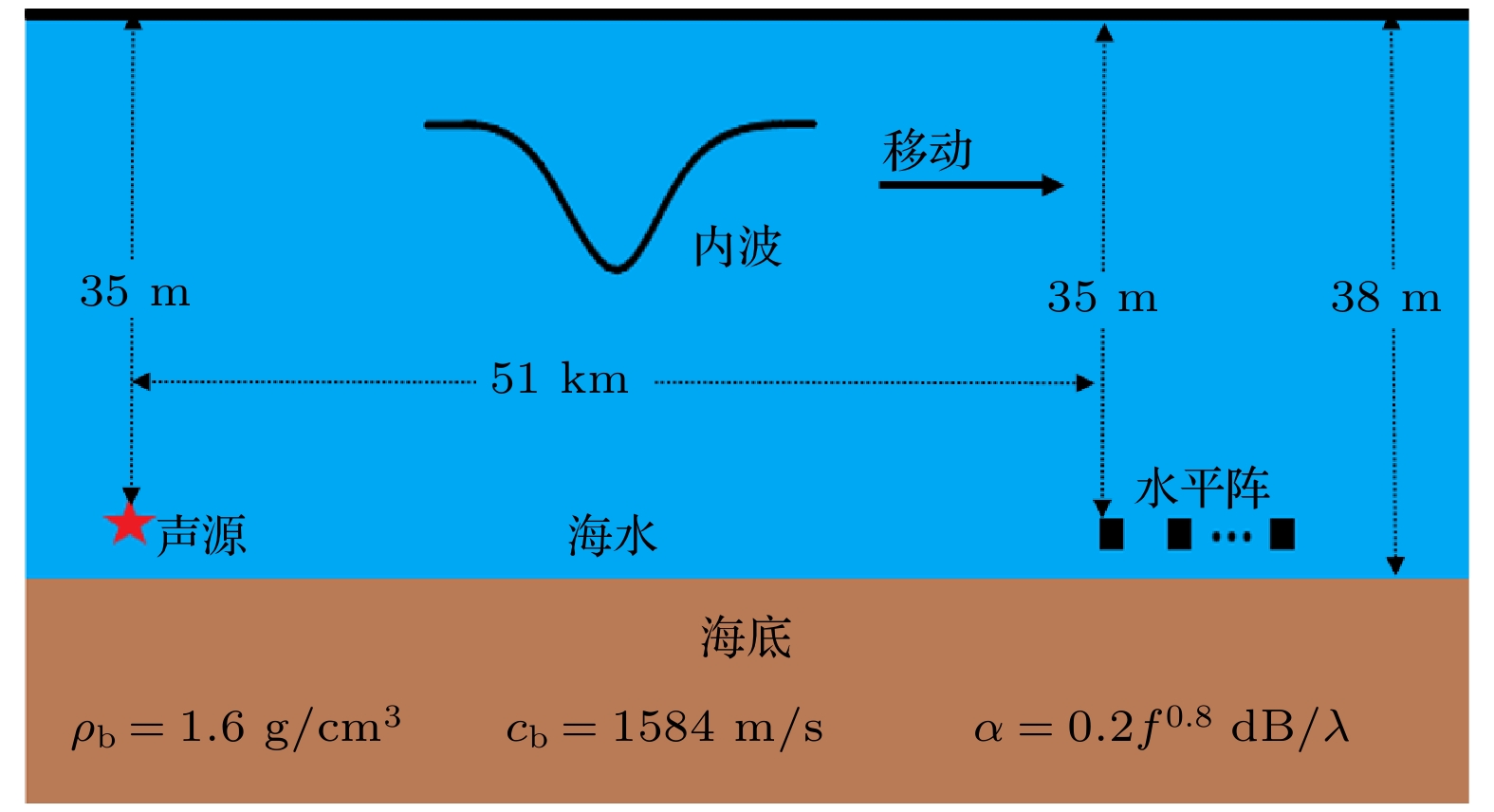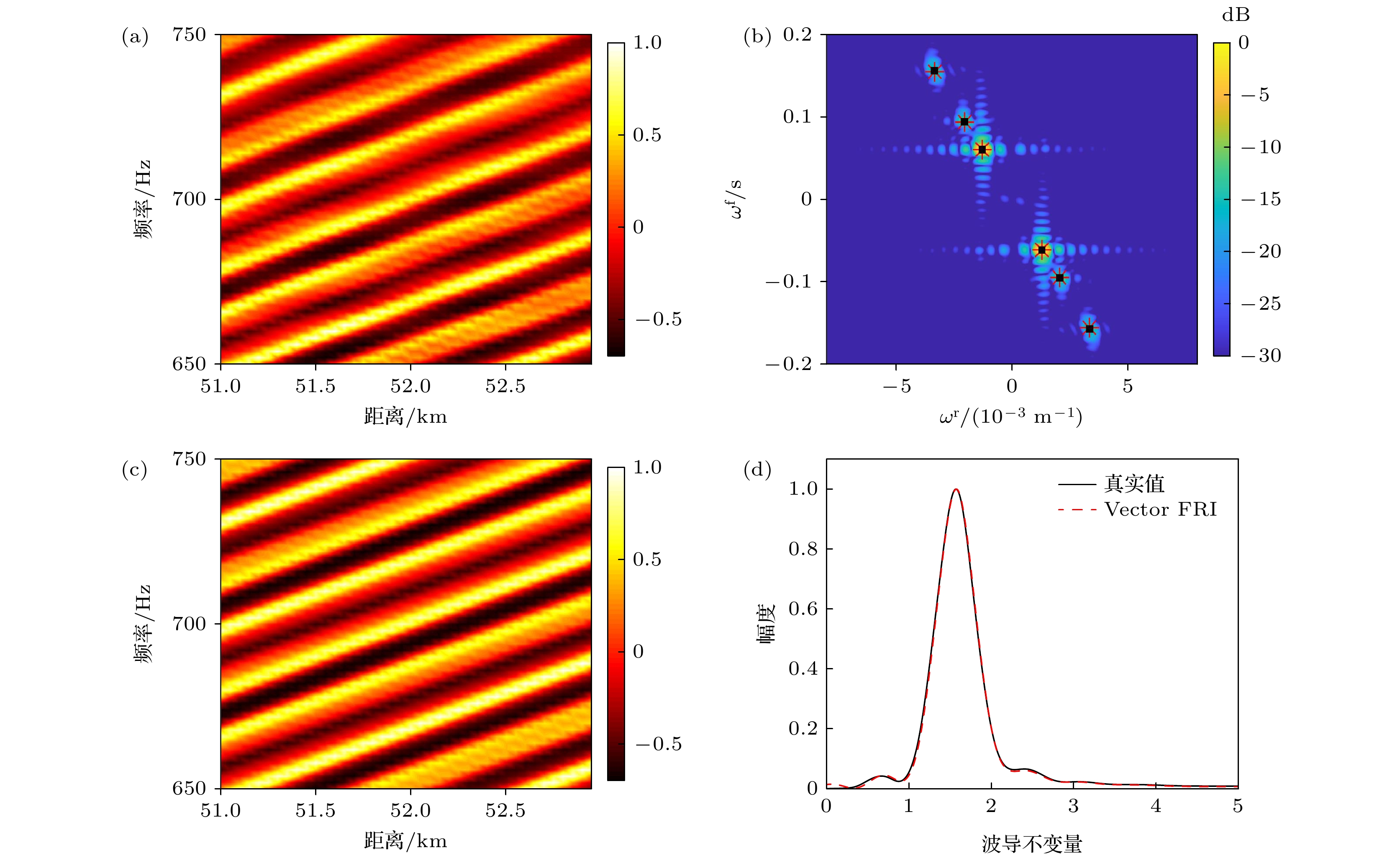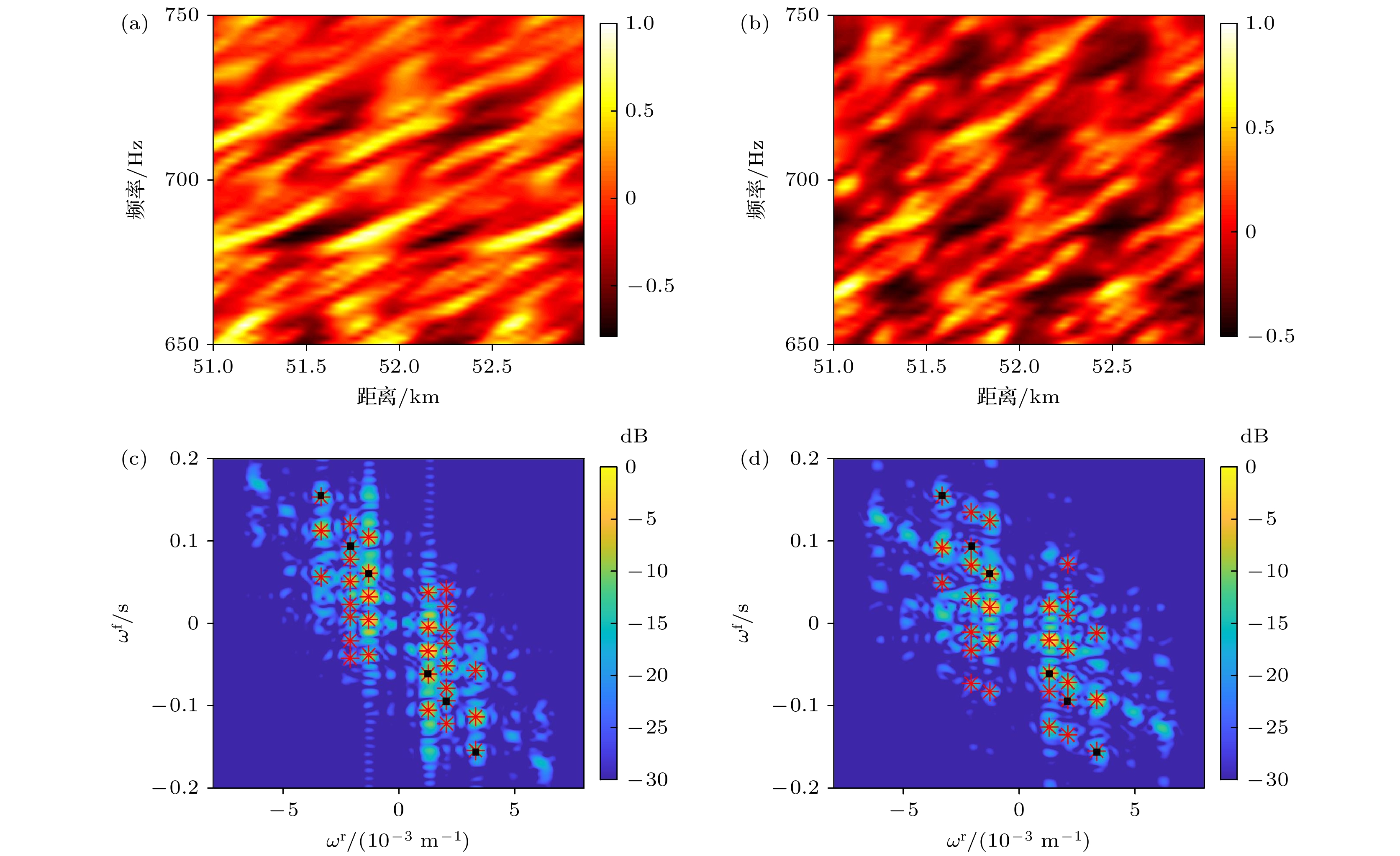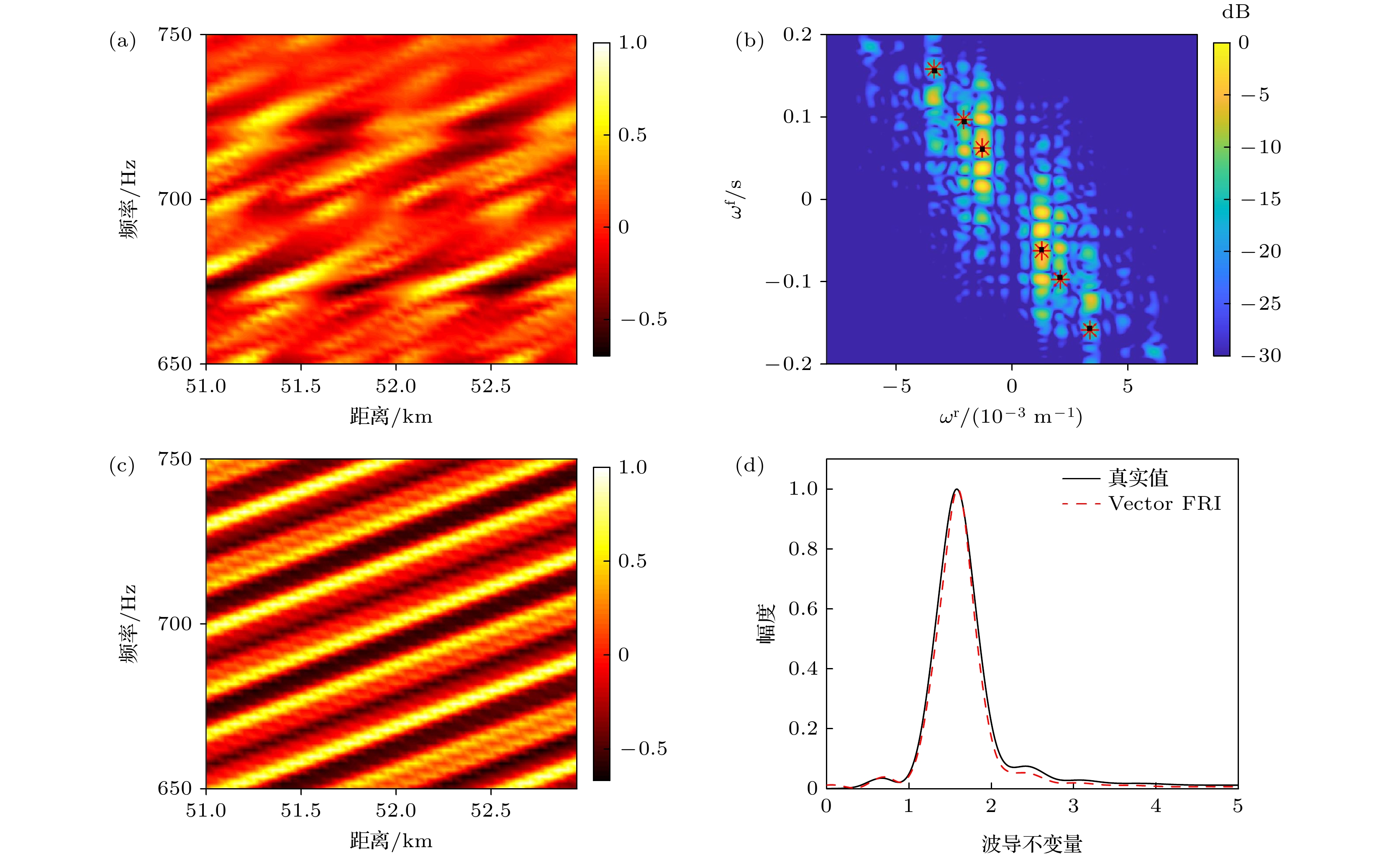-
To reduce the distortion of acoustic interference fringes caused by internal waves in shallow water, a sparse reconstruction method of acoustic interference fringes is proposed in this paper according to the coupled mode theory. The proposed method consists of two steps: 1) The interference fringes are approximated to the sum of several two-dimension sinusoids, which are sparsely reconstructed by the vector finite rate of innovation method. 2) According to coupled mode theory, two-dimension frequencies related to uncoupled mode pairs do not vary with the location of internal waves. However, two-dimension frequencies related to coupled mode pairs vary with the location of internal waves. So these frequencies are classified into two parts. The uncoupled mode pairs are used to recover the regular interference fringes and estimate the waveguide invariant in the background environment. The coupled mode pairs are used to track the locations of internal waves. The simulation results show that the proposed method can effectively provide interference fringe reconstruction, waveguide invariant estimation, and internal wave tracking in the internal wave environment.
[1] Chuprov S D 1982 Ocean Acoustic: Current State (Moscow: Nauka) p71
[2] Brekhovskikh L M, Lysanov Y P 1991 Fundamentals of Ocean Acoustics (2nd Ed.) (NewYork: Springer) pp140–145
[3] Cockrell K L, Schmidt H 2010 J. Acoust. Soc. Am. 127 2780
 Google Scholar
Google Scholar
[4] Turgut A, Orr M, Rouseff D 2010 J. Acoust. Soc. Am. 127 73
 Google Scholar
Google Scholar
[5] Kim S, Kuperman W, Hodgkiss W, Song H C, Edelmann G F, Akal T 2003 J. Acoust. Soc. Am. 114 145
 Google Scholar
Google Scholar
[6] Song H C, Kuperman W, Hodgkiss W 1998 J. Acoust. Soc. Am. 103 3234
 Google Scholar
Google Scholar
[7] Ren Q Y, Hermand J P 2013 J. Acoust. Soc. Am. 133 82
 Google Scholar
Google Scholar
[8] Heaney K D 2004 IEEE J. Oceanic Eng. 29 88
 Google Scholar
Google Scholar
[9] Hu T, Krolik J L 2008 J. Acoust. Soc. Am. 123 1338
 Google Scholar
Google Scholar
[10] 高飞, 徐芳华, 李整林, 秦继兴 2022 71 204301
 Google Scholar
Google Scholar
Gao F, Xu F H, Li Z L, Qin J X 2022 Acta Phys. Sin. 71 204301
 Google Scholar
Google Scholar
[11] 李沁然, 孙超, 谢磊 2022 71 024302
 Google Scholar
Google Scholar
Li Q R, Sun C, Xie L 2022 Acta Phys. Sin. 71 024302
 Google Scholar
Google Scholar
[12] Song W H, Wang N, Gao D Z, Wang H Z, Hu T, Guo S M 2017 J. Acoust. Soc. Am. 142 1848
 Google Scholar
Google Scholar
[13] Rouseff D 2001 Waves Random Media 11 377
 Google Scholar
Google Scholar
[14] Li X L, Song W H, Gao D Z, Gao W, Wang H Z 2020 J. Acoust. Soc. Am. 147 EL363
 Google Scholar
Google Scholar
[15] 宋文华, 胡涛, 郭圣明, 马力 2014 63 194303
 Google Scholar
Google Scholar
Song W H, Hu T, Guo S M, Ma L 2014 Acta Phys. Sin. 63 194303
 Google Scholar
Google Scholar
[16] Remi E, Julien B, Marie G, Xavier C, Thierry C 2018 J. Acoust. Soc. Am. 143 3444
 Google Scholar
Google Scholar
[17] Le G Y, Bonnel J 2013 J. Acoust. Soc. Am. 134 EL230
 Google Scholar
Google Scholar
[18] Yang T C, Huang C F, Huang S H, Liu J Y 2016 IEEE J. Oceanic Eng. 42 663
 Google Scholar
Google Scholar
[19] Thode A M 2000 J. Acoust. Soc. Am. 108 1582
 Google Scholar
Google Scholar
[20] 田玲爱, 刘福臣, 周士弘 2009 声学与电子工程 96 22
Tian L A, Liu F C, Zhou S H 2009 Acoustics and Electronics Engineering 96 22
[21] Guo R M, Li Y F, Thierry B, Zhao H F 2022 IEEE Trans. Signal Process. 70 4369
 Google Scholar
Google Scholar
[22] Li Y F, Guo R M, Thierry B, Zhao H F 2021 IEEE Trans. Signal Process. 69 4102
 Google Scholar
Google Scholar
[23] Colosi J A 2008 J. Acoust. Soc. Am. 124 1452
 Google Scholar
Google Scholar
[24] Yang T C 2014 J. Acoust. Soc. Am. 135 610
 Google Scholar
Google Scholar
[25] 马树青 2011 博士学位论文 (哈尔滨: 哈尔滨工程大学)
Ma S Q 2011 Ph. D. Dissertation (Harbin: Harbin Engineering University) (in Chinese)
-
图 4 背景声速剖面干涉条纹的稀疏表示 (a)规则干涉条纹(无内波); (b)干涉条纹的二维频谱(背景图表示2D-FFT谱, 黑色方块表示KRAKEN计算的真实中心频率, 红色星号表示vector-FRI估计频率); (c) vector FRI重建的干涉条纹; (d)利用2D-FFT方法计算出的背景环境干涉条纹(黑线)和vector FRI恢复的干涉条纹(红线)对应的波导不变量分布
Figure 4. Sparse representation of interference fringes in background sound speed profile: (a) Regular interference fringes (without internal wave); (b) 2D Fourier spectrum of interference fringes (the background color represents the results of 2D-FFT, the black square represents the true center frequencies calculated by KRAKEN, and the red asterisk represents frequencies estimated by vector FRI); (c) interference fringes recovered by vector FRI; (d) waveguide invariant distributions of regular interference fringes (black line) in background sound speed profile and vector FRI recovery interference fringes(red line), calculated by the 2D-FFT method, are shown
图 5 存在内波环境下干涉条纹图和对应的二位频谱图 (a)和(b)分别表示内波位置距声源24 km和35 km处的干涉条纹图; (c)和(d)分别表示(a)和(b)中干涉条纹的二维频谱图. 背景图表示2D-FFT谱, 黑色方块表示KRAKEN计算的真实中心频率, 红色星号表示vector-FRI估计频率
Figure 5. (a) and (b) represent the interference fringes when the positions of internal waves are 24 km and 35 km away from the source, respectively; (c) and (d) are the 2D frequency spectrum of interference fringes in panels (a) and (b), respectively. The background color is the result of 2D FFT. The black square represents the true center frequencies calculated by KRAKEN. The red asterisk represents frequencies estimated by vector FRI
图 6 (a)规则干涉条纹(真实值)及内波位置为24和35 km时干涉条纹的距离维频谱; (b)利用2D-FFT方法计算出的规则干涉条纹(真实值)及内波位置为24和35 km时干涉条纹的波导不变量分布
Figure 6. (a) Frequency spectrums in range of regular interference fringes (ground truth) and interference fringes with internal wave locations at 24 km and 35 km; (b) waveguide invariant distributions of regular interference fringes (ground truth) and interference fringes with internal wave locations at 24 km and 35 km, calculated by the 2D FFT method
图 7 (a)距离维频率
$ \omega^{{\rm{r}}} = k_{12} $ 时, 频率维频率随时间的变化, 其中, 背景图表示傅里叶变换的结果,$ \times $ 表示vector FRI的估计结果, 红色直线表示由未耦合模对频率(频率不随时间变化)拟合的直线, 蓝色直线表示由耦合模对频率(频率随时间变化)拟合的直线; (b)利用耦合模对频率估计出的内波轨迹Figure 7. (a) Frequency in the frequency dimension versus time when The frequency in the range dimension
$ \omega^{{\rm{r}}} = k_{12} $ , where the background color is the result of Fourier transform and$ \times $ the estimated results of vector FRI; (b) trajectory of the internal wave estimated by the frequencies related to coupled modes图 8 水下声场干涉条纹图的重构以及波导不变量的恢复; (a)内波环境下(
$r_{0} = 20\; \text{km}$ )的声场干涉条纹图; (b)内波环境下($r_{0} = 20\; \text{km}$ )声场干涉条纹图的二维傅里叶频谱, 背景图为2DFFT结果, 黑色方块表示KRAKEN计算的真实中心频率, 红色星号表示vector-FRI估计的未耦合模对频率; (c)利用未耦合模对重建的干涉条纹图; (d)波导不变量分布. 红线为内波环境下重建干涉条纹对应的波导不变量, 黑线为背景场(无内波)对应的波导不变量分布Figure 8. Recovered interference fringes of underwater acoustic field and the recovery of waveguide invariant: (a) Interference fringes of acoustic field in internal wave environment (
$r_{0} = 20\; \text{km}$ ). (b) 2D Fourier spectrum of interference fringes in internal wave environment ($r_{0} = 20\; \text{km}$ ). The background color is the result of 2D-FFT. The black square represents the true center frequencies calculated by KRAKEN. The red asterisk represents frequencies estimated by vector FRI. (c) Recovered interference fringes using uncoupled mode pairs. (d) Distribution of waveguide invariants. The red line is the distribution of waveguide invariants corresponding to the reconstruction of interference fringes in the internal wave environment, and the black line is the distribution of waveguide invariants corresponding to the background field (without internal waves)表 1 不同未耦合模对波导不变量的估计结果
Table 1. Results of waveguide invariants related to different mode pairs
$ \beta $ $ \beta_{12} $ $ \beta_{23} $ $ \beta_{13} $ 理论值 估计值 理论值 估计值 理论值 估计值 无内波 1.51—1.57 1.556 1.54—1.64 1.599 1.53—1.61 1.585 有内波 1.51—1.57 1.555 1.54—1.64 1.593 1.53—1.61 1.595 -
[1] Chuprov S D 1982 Ocean Acoustic: Current State (Moscow: Nauka) p71
[2] Brekhovskikh L M, Lysanov Y P 1991 Fundamentals of Ocean Acoustics (2nd Ed.) (NewYork: Springer) pp140–145
[3] Cockrell K L, Schmidt H 2010 J. Acoust. Soc. Am. 127 2780
 Google Scholar
Google Scholar
[4] Turgut A, Orr M, Rouseff D 2010 J. Acoust. Soc. Am. 127 73
 Google Scholar
Google Scholar
[5] Kim S, Kuperman W, Hodgkiss W, Song H C, Edelmann G F, Akal T 2003 J. Acoust. Soc. Am. 114 145
 Google Scholar
Google Scholar
[6] Song H C, Kuperman W, Hodgkiss W 1998 J. Acoust. Soc. Am. 103 3234
 Google Scholar
Google Scholar
[7] Ren Q Y, Hermand J P 2013 J. Acoust. Soc. Am. 133 82
 Google Scholar
Google Scholar
[8] Heaney K D 2004 IEEE J. Oceanic Eng. 29 88
 Google Scholar
Google Scholar
[9] Hu T, Krolik J L 2008 J. Acoust. Soc. Am. 123 1338
 Google Scholar
Google Scholar
[10] 高飞, 徐芳华, 李整林, 秦继兴 2022 71 204301
 Google Scholar
Google Scholar
Gao F, Xu F H, Li Z L, Qin J X 2022 Acta Phys. Sin. 71 204301
 Google Scholar
Google Scholar
[11] 李沁然, 孙超, 谢磊 2022 71 024302
 Google Scholar
Google Scholar
Li Q R, Sun C, Xie L 2022 Acta Phys. Sin. 71 024302
 Google Scholar
Google Scholar
[12] Song W H, Wang N, Gao D Z, Wang H Z, Hu T, Guo S M 2017 J. Acoust. Soc. Am. 142 1848
 Google Scholar
Google Scholar
[13] Rouseff D 2001 Waves Random Media 11 377
 Google Scholar
Google Scholar
[14] Li X L, Song W H, Gao D Z, Gao W, Wang H Z 2020 J. Acoust. Soc. Am. 147 EL363
 Google Scholar
Google Scholar
[15] 宋文华, 胡涛, 郭圣明, 马力 2014 63 194303
 Google Scholar
Google Scholar
Song W H, Hu T, Guo S M, Ma L 2014 Acta Phys. Sin. 63 194303
 Google Scholar
Google Scholar
[16] Remi E, Julien B, Marie G, Xavier C, Thierry C 2018 J. Acoust. Soc. Am. 143 3444
 Google Scholar
Google Scholar
[17] Le G Y, Bonnel J 2013 J. Acoust. Soc. Am. 134 EL230
 Google Scholar
Google Scholar
[18] Yang T C, Huang C F, Huang S H, Liu J Y 2016 IEEE J. Oceanic Eng. 42 663
 Google Scholar
Google Scholar
[19] Thode A M 2000 J. Acoust. Soc. Am. 108 1582
 Google Scholar
Google Scholar
[20] 田玲爱, 刘福臣, 周士弘 2009 声学与电子工程 96 22
Tian L A, Liu F C, Zhou S H 2009 Acoustics and Electronics Engineering 96 22
[21] Guo R M, Li Y F, Thierry B, Zhao H F 2022 IEEE Trans. Signal Process. 70 4369
 Google Scholar
Google Scholar
[22] Li Y F, Guo R M, Thierry B, Zhao H F 2021 IEEE Trans. Signal Process. 69 4102
 Google Scholar
Google Scholar
[23] Colosi J A 2008 J. Acoust. Soc. Am. 124 1452
 Google Scholar
Google Scholar
[24] Yang T C 2014 J. Acoust. Soc. Am. 135 610
 Google Scholar
Google Scholar
[25] 马树青 2011 博士学位论文 (哈尔滨: 哈尔滨工程大学)
Ma S Q 2011 Ph. D. Dissertation (Harbin: Harbin Engineering University) (in Chinese)
Catalog
Metrics
- Abstract views: 4936
- PDF Downloads: 113
- Cited By: 0














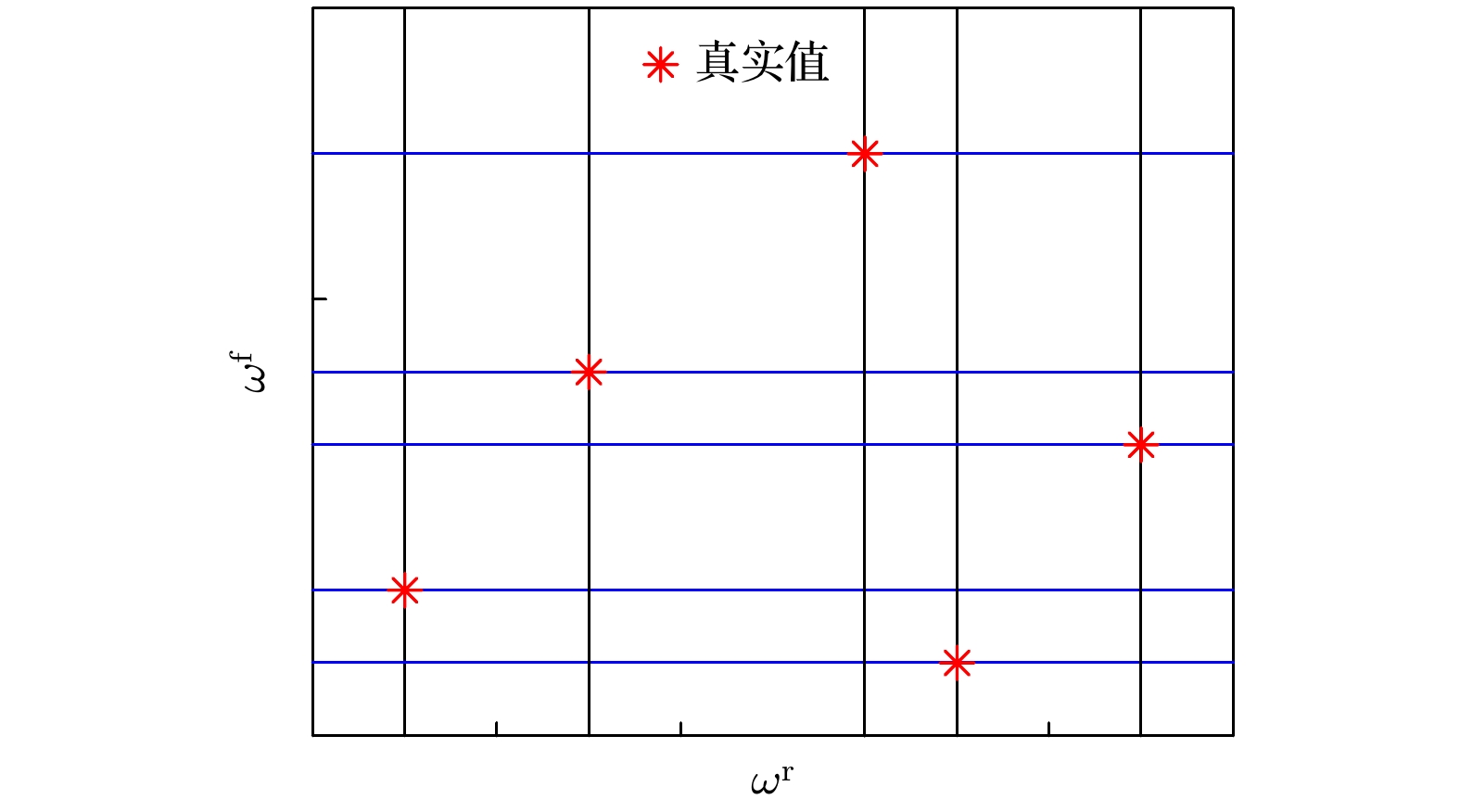
 DownLoad:
DownLoad:
